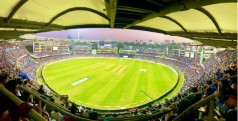



















Saturday, Sep 16, 2023 21:45 [IST]
Last Update: Saturday, Sep 16, 2023 16:16 [IST]
Two Murals from Two Corners
On this Ganesh Chathurthi occasion, let us travel to two extreme corners of India (Bharath) to have a darshan of two murals of Ganapathi (as He known in Keralam) alias Tsog gi dag po (‘t’ is silent as in Tsunami) or Mar po (as He is known in Tibetan Buddhism in Sikkim). Murals are paintings on permanent surfaces like wall, ceiling or rocks.
I saw this Ganapathi mural on the outer wall of Sri Guruvayurappan (Krishnan) Temple in Guruvayur, Keralam - mural of a Saivaite God in a Vaishnavaite Temple. In this mural Ganapathi is seated majestically on a padma peetam (lotus-based seat), holding a modak / mothagam in His left palm from the pot full of kozhukkattai (modak) placed before him. On His right hand is the broken left tusk that He used to write down the Mahabarath epic as described by Saint Vyasar. His other right hand holds a weapon and the other left hand holds a cloth noose. A serpent is seen around His neck, perhaps Vasuki. He is depicted with a third eye which is new to me!), holding a tiny pot in the curled trunk. Two Keralam-style traditional lamps on either side lighten up the surrounding. A few other offerings could be in the utensils to His right. Perhaps a pious devotee has thoughtfully kept a can of drinking water and a flask of ‘kaappi’ (coffee) / ‘kattan chhaya’ (black tea) for Ganapathi!
Keralam murals date back from 15th century; it is said that most of the noted mural art works were done from 15th to 19th centuries. Some rare murals even go back to 8th century. Only natural colours are used in traditional mural work, like pigments / gums / resin from minerals / plants; even brushes are made of natural materials only. Colours like saffron-yellow, saffron-red, green, white, black, red, blue, golden-yellow are widely used. Kerala’s temples and palaces are treasure houses of such mural art. I even noticed murals done on the outer wall of the sanctum sanctorum of the hoary Padmanabhaswamy Temple in Thiruvananthapuram; but they are badly in need of immediate restoration. The murals are mostly Hindu religion oriented.
The oldest of Keralam murals are found in the Thirunandikkara Cave temple, now a part of Kanyakumari district in the neighbouring State of Tamil Nadu. The largest mural panel in Keralam, called the Gajendra Moksha, is at the Krishnapuram Palace near Kayamkulam in Alappuzha district. Extensive murals depicting scenes from the Hindu epics, the Ramayana and the Bhagavatha, are preserved at the Mattancherry Palace in Ernakulam district. The murals of the Shiva Temple at Ettumanoor provide insights into the earliest forms of Dravidian mural art.
Now, let us go to the North-East State of Sikkim from the South-West State of Keralam, covering more than 3,000 kms. This mural of Tsog gi dag po (Raktha Ganpathi), as He is known in the tantric Tibetan Buddhism (Lamaism / Vajrayanam), attracted my attention at the Rumtek Monastery, across Gangtok on the opposite hill slope, in Sikkim, during my first visit on 14th July 1984. Here in this Tibetan-styled mural, Tsog gi dag po holds a modak in his left palm [as is the practice, or is it a momok (‘k’ silent)]! The back left palm holds a rosary. His right hands hold a white radish (yes, a radish, indeed!) and a mace respectively. A notable feature is that He is not depicted holding His half-broken left tusk as in Hinduism. He is seated cross-legged with two pots of offerings before him. The radish symbolizes the essence of the earth element, it is believed.
Rumtek Monastery belongs to the Karma Kagyu sect, one of the five sects of Tibetan Buddhism. His Holiness Gyalwa Karmapa, the 16th head of this Sect, took refuge in India in 1959 after Tibet’s occupation by China in 1950. It was due to his efforts that this Karmapa Centre came up in Rumtek as the Sect’s Headquarters and was finally completed in 1966. As desired by him, this mural was done in the monastery. In Sikkim, Rumtek Monastery is considered the biggest among all the monasteries. Rumtek Monastery is modeled on the Karma Kagyu Sect’s original headquarters, the Tsurphu Monastery (needless to say ‘T’ is silent here also), in Tibet (No, ‘T’ is not silent here). Lord Tsog gi dag po smiled at me when I visited the Monastery again in 2014, after 30 years. This time I clicked Mar po with a digital camera, not my earlier analog camera with a film roll.
When I searched the Net to know about Tibetan murals (you see, I am not an art expert specializing on murals), it is full with only one detail - A $ 12,000 book ‘Murals of Tibet’ by American author & photographer Thomas C. Laird! So I am unable to steal any info from the Net on Tibetan murals as input for this article, excepting the fact that Tibetan mural art form is more than a thousand year old tradition. Tibet is no doubt the a mind blowing treasure trove of Buddhist religious arts & crafts.
In Vajrayana pantheon, Tsog gi dag po occupies a small place, not as prominent as in Hindu religion. The enlightened Ganapati is considered the emanation of the Bodhisattva Avalokiteshvara, the God of Compassion. But one unique similarity in these two murals is that Ganapathi’s vaahan (mount), the mooshika (mouse), is not depicted.
krishnanbala2004@yahoo.co.in / 9840917608 Whatsapp
